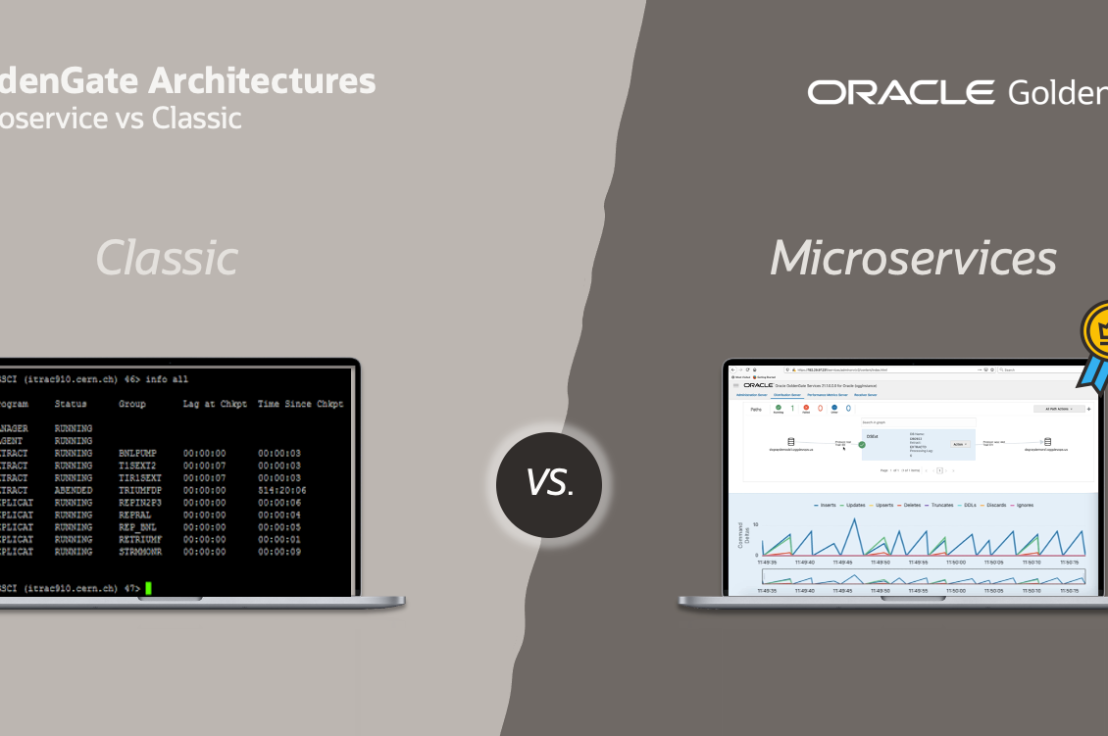Every once in a while, I’ve gotten a question about what are the main advantages of Microservices Architecture over Classic Architecture. In this article, I am trying to summarize the most relevant point at a high level. If you would like more details in any area, please feel free to reach out.

The Oracle GoldenGate Microservices product represents the vision of the future of data replication since it has significant advantages over its predecessor, GoldenGate Classic. The following are some main advantages:
Enhanced Flexibility and Scalability:
Microservices architecture: The modular structure enables Distribution Server (PUMP replacement), Extract, and Replicat to scale independently to meet different workloads. In contrast, Classic’s monolithic architecture requires scaling the entire system.
Multiple communication protocols are supported by microservices, giving them greater flexibility for various network conditions and requirements. These protocols include WebSockets, Web Services, UDP, and OGG.

Enhanced Automation and Manageability
RESTful API: Using web pages, the command line, and APIs, Microservices offers a modern, programmatic interface for administration, configuration, and monitoring. Compared to the file-based configuration of Classic, this facilitates automation and streamlines administration. To me, the REST is the best feature in GoldenGate Microservices compared to Classic.
Centralized Service Manager: This makes maintenance and troubleshooting easier by providing a comprehensive overview of all active services and their configurations through a single online interface.
Performance measures in real-time: Proactive performance improvement is made possible by real-time insights into resource use, queue depths, and data flow. Explore the performance metrics service, as it will be the base information for the integration with Telegraph in the new 23c
Improved Reliability and Security
SSL support: Data confidentiality and secure communication between services are ensured by Secure Socket Layer (SSL) encryption. Classic requires further settings because it lacks encryption by default.

User management: Microservice’s different role-level access can be granted to GoldenGate users.

High availability: Microservices maximize uptime and data availability by providing built-in redundancy and failover options for essential services as part of the Oracle MAA strategy.

Additional advantages
Streamlined deployment and upgrades: Simplified installation and migration process compared to Classic.

Modern user interface: Again, Web-based GUI provides a user-friendly experience for configuration and monitoring while you can still use the command line interface “adminclient” and write your own customization with REST APIs.
Reduced cost of ownership: Scalability and efficiency improvements can lead to lower hardware and maintenance costs.
Here’s a quick table summarizing the key differences:

| Feature | GoldenGate Classic | GoldenGate Microservices |
|---|---|---|
| Architecture | Monolithic | Microservices |
| Scalability | Limited | Independent scaling of services |
| Communication protocols | Limited (Oracle GoldenGate Protocol) | Multiple protocols (WebSockets, Web Services, UDP, OGG) |
| Manageability | File-based configuration | RESTful API and central Service Manager |
| Security | Optional SSL | Built-in SSL |
| High availability | Requires additional configuration (MAA) | Requires additional configuration (MAA) |
| Deployment | Complex | Simplified |
| User interface | Command line and text files (ggsci) | Web-based GUI, AdminClient and REST API |
Summary
While GoldenGate Classic remains a reliable and proven solution for some scenarios, GoldenGate Microservices offers significant advantages in scalability, flexibility, manageability, security, and cost, making it the preferred choice for most modern data replication requirements. It’s worth mentioning that in the new 23c release, GoldenGate will be available as Microservice only.
Finally, I would like to highlight the complete GoldenGate family of solutions, which offers comprehensive features for data integration needs.



I hear you Matt. I also loved the simplicity of the classic. But one thing i really like on Microservices is how easy it’s to automate routines and create custom solutions. In addition adminclient still available just like ggsci. If you would like we can setup a call and i can explain better. I will be happy to help.
LikeLike
Microservices is for stupid people who don’t know how to use the command line and need a pretty GUI with red for down and green for up. Simply point and click and not know what is actually being built. If Service Manager website goes down 99% wouldn’t know what to do. Continually trying to dumb down technology and continually creating dumb “engineers”.
LikeLike
I don’t think you are completely wrong, i myself am more of old school but there are some advantages to quickly access your env. “Stupid” was a little harsh i thought.
LikeLike
Maybe a little harsh, but annoyed with 23ai GG being microservices only. Currently have a 21c classic in a broadcast setup to multiple targets, not all of them Oracle. Easy to manage/maintain through ggsci and integrated all my scripts with ansible to easily deploy to lower environments after environment refreshes. Would be nice if vendors continued to allow those of us that like to code and know what is going on under the covers the ability to continue to do that, instead of forcing to hold my hand with point and click only.
LikeLike